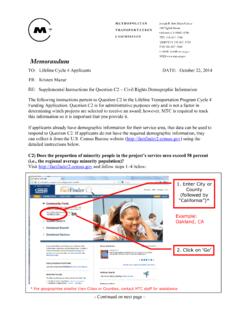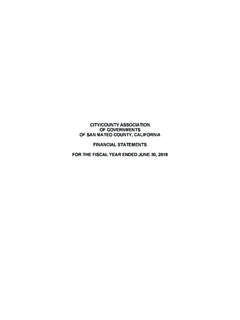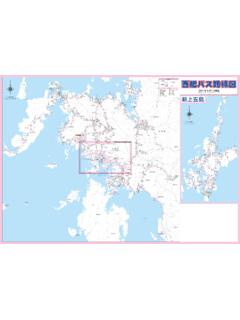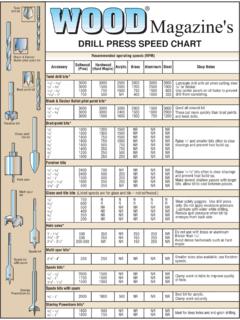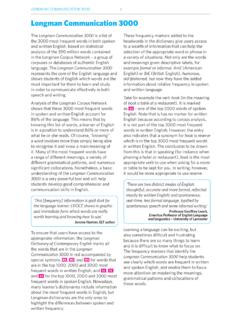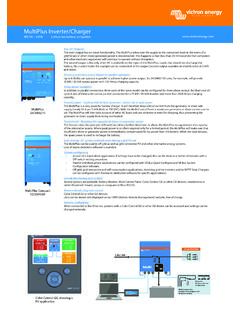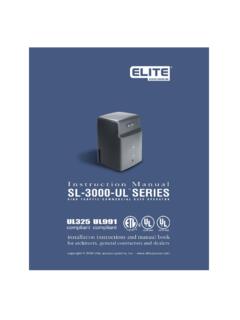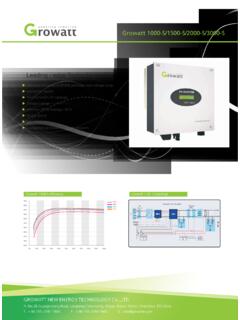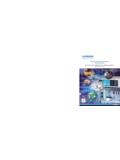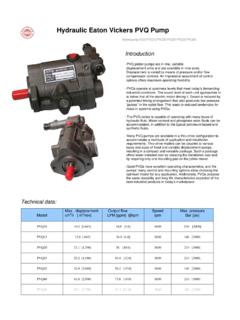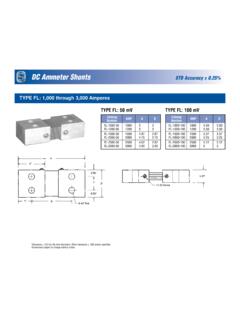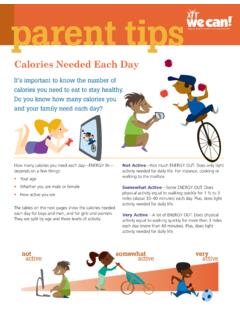Transcription of APPENDIX B Traffic Level of Service Calculation Methods
1 APPENDIX B Traffic Level of Service Calculation Methods B-1 APPENDIX B Traffic Level of Service Calculation Methods Level of Service (LOS) is a term used to qualitatively describe the operating conditions of a roadway based on factors such as speed, travel time, maneuverability, delay, and safety. The Level of Service of a facility is designated with a letter, A to F, with A representing the best operating conditions and F the worst. There are many Methods available to calculate the levels of Service for the various types of roadways and intersections that comprise San Mateo County's designated system for the 1997 Congestion Management Program (CMP). The components of the 1997 CMP Roadway System include freeways, such as 101 and I-280; multilane highways; two-lane highways, such as State Route 1 (SR 1), south of Linda Mar; major arterials, such as SR 82 (El Camino Real); and major intersections.
2 Operational analyses of specific weaving sections and ramp junctions have not been included in the 1995 CMP but may be added for subsequent CMPs. AB 471 and AB 1963, the CMP legislation, require that Methods of calculating levels of Service defined either by the latest version of the Highway Capacity Manual (HCM) or by the Transpor-tation Research Board's Circular 212 be used for the analysis of CMP roadways. The latest update to the HCM published in 1994 specifies Level of Service Methods for freeways, multilane highways, two-lane highways, arterials, freeway weaving sections, ramp junctions, signalized intersections, and unsignalized intersections. The TRB's Circular 212 describes Methods for signalized and unsignalized intersections. The Level of Service (LOS) Calculation Methods found in the 1994 HCM for freeways, multilane highways, two-lane highways, and arterials and the Calculation for signalized intersections based on TRB's Circular 212 method are described in this APPENDIX .
3 Level of Service Calculation Methods The Methods selected to calculate levels of Service for the roadway (freeway, multilane highway, two-lane highway, and arterial) segments and intersections included in the CMP network are described below: Freeways A freeway is defined as a divided highway facility with two or more lanes in each direction and full control of access and egress. It has no intersections; access and egress are provided by ramps at interchanges. According to the latest version of the Highway Capacity Manual (1994 HCM), the LOS of freeway segments is based on the density of vehicles, expressed in passenger cars per mile per lane. The LOS can also be evaluated with volume-to-capacity (V/C) ratios, average travel B-2 . speeds, and maximum Service flow rates. The specific LOS criteria for freeways are presented in Table B-1. Illustrations of the various levels of Service are presented on Figure B-1.
4 The selected LOS method for freeway segments is based on calculating V/C ratios for each direction of travel, wherein the Traffic volume for each segment is divided by the capacity of the segment. The volumes are obtained from counts for existing conditions or from a travel forecasting model for future conditions. The capacity is estimated as the number of lanes multiplied by 2,200 vehicles per hour per lane four four-lane freeway segments and 2,300 vehicles per hour per lane for segments with six or more lanes. The V/C ratios are calculated and related to LOS based on the relationships presented in Table B-1. Another method of calculating a freeway segment's Level of Service is to determine the average travel speed from floating car runs. Descriptions of the average travel speeds for each LOS designation are also presented in Table B-1. Multilane Highways Multilane highways generally have posted speed limits of between 40 and 55 miles per hour (mph).
5 They usually have four or six lanes, often with physical medians or two-way left-turn lane medians, although they may also be undivided (have no median). Unlike freeways, multilane highways are interrupted by intersections or driveways. The Level of Service criteria for multilane highways are similar to the criteria for freeways. The specific criteria from the HCM are presented in Table B-2. The LOS Calculation method is identical to the Calculation method for freeways. The only difference is the range of V/Cs and speeds for each LOS designation. The maximum ideal lane capacity for a multilane highway segment is 2,200 vehicles per hour. Two-Lane Highways A two-lane highway is defined as a two-lane roadway with one lane for use by Traffic in each direction. Passing of slower vehicles requires use of the opposing lane. As volumes or geomet-ric constraints increase, the ability to pass decreases and platoons of vehicles are formed.
6 The delay experienced by motorists also increases. The LOS for two-lane highways is based on mobility. The specific LOS criteria from the 1994 HCM are presented in Table B-3. For two-lane highways, the selected method, based on V/Cs, takes into account the volume in both directions. The total volume is divided by the total capacity of 2,800 vehicles per hour. The corresponding V/C is correlated to a LOS based on the V/C ranges in Table B-3. Average travel speeds for each LOS designation are also presented in this table. Table B-1 1994 HCM Level of Service Criteria for Basic Freeway Sections 70 mph Free-Flow Speed 65 mph Free-Flow Speed 60 mph Free-Flow Speed LOS Densitya (pc/mi/ln) Speedb (mph) Maximumc V/C MSFd (pcphpl) Densitya (pc/mi/ln) Speedb (mph) Maximumc V/C MSFd (pcphpl) Densitya (pc/mi/ln) Speedb (mph) Maximumc V/C MSFd (pcphpl) A # $ 700 # $ 650 # 600 B # $ 1,120 # $ 1,040 # 960 C # $ 1,644 # $ 1,548 # 1,440 D # $ 2,015 # $ 1,952 # 1,824 E # $ 2,200/2,300 # $ 2,200/2,300 # 2,200/2,300 F Variable Variable Variable Variable Variable Variable Variable Variable Variable Variable Variable Variable a Density in passenger cars per mile per lane.
7 B Average travel speed in miles per hour. c Maximum volume-to-capacity ratio. d Maximum Service flow rate under ideal conditions in passenger cars per hour per lane. # less than or equal to $ greater than or equal to Note: In table entries with split values, the first value is for four-lane freeways, and the second is for six- and eight-lane freeways. Source: Transportation Research Board, Highway Capacity Manual, Special Report 209 (Washington, , 1994), pp. 3-9. Table B-2 Level of Service Criteria for Multilane Highways 60 mph Free-Flow Speed 55 mph Free-Flow Speed 50 mph Free-Flow Speed LOS Densitya (pc/mi/ln) Speedb (mph) Maximumc V/C MSFd (pcphpl) Densitya (pc/mi/ln) Speedb (mph) Maximumc V/C MSFd (pcphpl) Densitya (pc/mi/ln) Speedb (mph) Maximumc V/C MSFd (pcphpl) A # 12 $ 60 720 # 12 $ 55 660 # 12 $ 50 600 B # 20 $ 60 1,200 # 20 $ 55 1,100 # 20 $ 50 1,000 C # 28 $ 59 1,650 # 28 $ 54 1,510 # 28 $ 50 1,400 D # 34 $ 51 1,940 # 34 $ 53 1,800 # 34 $ 49 1,670 E # 40 $ 55 2,200 # 41 $ 51 2,100 # 43 $ 47 2,000 F > 40e < 55e -e -e > 41e < 51e -e -e > 43e < 47d -e -e a Density in passenger cars per mile per lane.
8 B Average travel speed in miles per hour. c Maximum volume-to-capacity ratio. d Maximum Service flow rate under ideal conditions in passenger cars per hour per lane. e Highly variable, unstable. # less than or equal to $ greater than or equal to Source: Transportation Research Board, Highway Capacity Manual, Special Report 209 (Washington, , 1994), pp. 7-8. Table B-3 Level of Service Criteria for General Two-Lane Highway Segments V/C Ratioa Level Terrain Rolling Terrain Mountainous Terrain % No-Passing Zone % No-Passing Zone % No-Passing Zone LOS % Time Delay Speed 0 20 40 60 80 100 Speed 0 20 40 60 80 100 Speed 0 20 40 60 80 100 A # 30 $ 58 $ 57 $ 56 B # 45 $ 55 $ 54 $ 54 C # 60 $ 52 $ 51 $ 49 D # 75 $ 50 $ 49 $ 45 E > 75 $ 45 $ 40 $ 35 F 100 < 45 -- -- -- -- -- -- < 40 -- -- -- -- -- -- < 35 -- -- -- -- -- -- aRatio of flow rate to an ideal capacity of 2.
9 800 passenger cars per hour in both directions. bAverage travel speed of all vehicles (in mph) for highways with design speed $ 60 mph; for highways with lower design speeds, reduce speed by 4 mph for each 10-mph reduction in design speed below 60 mph; assumes that speed is not restricted to lower values by regulation. #less than or equal to $greater than or equal to Source: Transportation Research Board, Highway Capacity Manual, Special Report 209 (Washington, , 1994), pp. 8-5. APPENDIX BCTraffic Level of Service Calculation Methods B-6 Arterials Levels of Service for arterials are dependent on the arterial class denoted as Type I, II, or III. Type I arterials are principal arterials with suburban design, 1 to 5 signals per mile, no parking, and free-flow speeds of 35 to 45 miles per hour (mph). Type III arterials have urban designs, with 6 to 12 signals per mile, parking permitted, and are undivided with free-flow speeds of 25 to 35 miles per hour.
10 Type II arterials fall between Type I and III and have free-flow speeds of 30 to 35 miles per hour. The LOS for an arterial is based on maneuverability, delays, and speeds. As the volume increases, the probability of stopping at an intersection due to a red signal indication increases and the LOS decreases. The specific LOS criteria from the HCM are presented in Table B-4. For the CMP, a Calculation method based on V/C was selected. Volumes on each roadway segment in each direction are divided by the capacity, estimated to be 1,100 vehicles per hour per lane. The capacity was estimated based on a saturation flow rate of 1,900 vehicles per lane and the assumption that El Camino Real would receive 60 percent of the green With the assumption that streets perpendicular to El Camino Real would receive 40 percent of each intersection's green time, the reduction in El Camino Real's capacity due to intersecting streets has been accounted for in the method used to analyze levels of Service of arterial streets.
